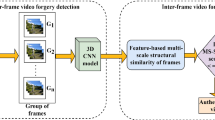Abstract
In recent years, video surveillance plays an important role in security applications as well as legal sectors. For example, CCTV footage can be submitted as evidence of a crime scene in a courtroom. However, the recorded video footage can be manipulated, for example, an object can be removed from a video through low-cost and easily available video editing tools. Any sensitive surveillance video should be verified before being accepted as a piece of evidence of events/circumstances. In this paper, we present a motion residual and Deep Learning based forensic approach to identify object-based forged frames in surveillance videos. Firstly, the motion residuals are computed from the videos sequences to extract the video forgery footprints, which are generated due to the manipulation operations. Secondly, the computed motion residuals are fed to VGG-16 network for detecting authentic and forged frames in a surveillance video.
Access this chapter
Tax calculation will be finalised at checkout
Purchases are for personal use only
Similar content being viewed by others
References
Abbasi Aghamaleki, J., Behrad, A.: Malicious inter-frame video tampering detection in MPEG videos using time and spatial domain analysis of quantization effects. Multimed. Tools Appl. 76(20), 20691–20717 (2016). https://doi.org/10.1007/s11042-016-4004-z
Aloraini, M., Sharifzadeh, M., Schonfeld, D.: Sequential and patch analyses for object removal video forgery detection and localization. IEEE Trans. Circuits Syst. Video Technol. 31(3), 917–930 (2020)
Bagiwa, M.A., Wahab, A.W.A., Idris, M.Y.I., Khan, S., Choo, K.K.R.: Chroma key background detection for digital video using statistical correlation of blurring artifact. Digit. Investig. 19, 29–43 (2016)
Bakas, J., Naskar, R.: A digital forensic technique for inter–frame video forgery detection based on 3D CNN. In: Ganapathy, V., Jaeger, T., Shyamasundar, R.K. (eds.) ICISS 2018. LNCS, vol. 11281, pp. 304–317. Springer, Cham (2018). https://doi.org/10.1007/978-3-030-05171-6_16
Bakas, J., Naskar, R., Nappi, M., Bakshi, S.: Object-based forgery detection in surveillance video using capsule network. J. Ambient. Intell. Humaniz. Comput. 1–11 (2021). https://doi.org/10.1007/s12652-021-03511-3
Chen, S., Tan, S., Li, B., Huang, J.: Automatic detection of object-based forgery in advanced video. IEEE Trans. Circuits Syst. Video Technol. 26(11), 2138–2151 (2016). https://doi.org/10.1109/TCSVT.2015.2473436
D’Avino, D., Cozzolino, D., Poggi, G., Verdoliva, L.: Autoencoder with recurrent neural networks for video forgery detection. Electron. Imaging 2017(7), 92–99 (2017)
Johnston, P., Elyan, E.: A review of digital video tampering: from simple editing to full synthesis. Digit. Investig. 29, 67–81 (2019)
Kodovskỳ, J., Fridrich, J.: Calibration revisited. In: Proceedings of the 11th ACM Workshop on Multimedia and Security, pp. 63–74 (2009)
Kodovsky, J., Fridrich, J.: Steganalysis of JPEG images using rich models. In: Media Watermarking, Security, and Forensics, vol. 8303, p. 83030A. International Society for Optics and Photonics (2012)
Kodovsky, J., Fridrich, J., Holub, V.: Ensemble classifiers for steganalysis of digital media. IEEE Trans. Inf. Forensics Secur. 7(2), 432–444 (2011)
Mizher, M.A., Ang, M.C., Mazhar, A.A., Mizher, M.A.: A review of video falsifying techniques and video forgery detection techniques. Int. J. Electron. Secur. Digit. Forensics 9(3), 191–208 (2017)
Nguyen, H.H., Yamagishi, J., Echizen, I.: Capsule-forensics: using capsule networks to detect forged images and videos. In: IEEE International Conference on Acoustics, Speech and Signal Processing (ICASSP), pp. 2307–2311 (2019)
Pandey, R.C., Singh, S.K., Shukla, K.K.: A passive forensic method for video: exposing dynamic object removal and frame duplication in the digital video using sensor noise features. J. Intell. Fuzzy Syst. 32(5), 3339–3353 (2017)
Richao, C., Gaobo, Y., Ningbo, Z.: Detection of object-based manipulation by the statistical features of object contour. Forensic Sci. Int. 236, 164–169 (2014)
Shanableh, T.: Detection of frame deletion for digital video forensics. Digit. Investig. 10(4), 350–360 (2013)
Simonyan, K., Zisserman, A.: Very deep convolutional networks for large-scale image recognition. In: Computer Science. arXiv preprint arXiv:1409.1556 (2014)
Sitara, K., Mehtre, B.M.: Digital video tampering detection: an overview of passive techniques. Digit. Investig. 18, 8–22 (2016)
Su, K., Kundur, D., Hatzinakos, D.: Statistical invisibility for collusion-resistant digital video watermarking. IEEE Trans. Multimedia 7(1), 43–51 (2005)
Su, Y., Han, Y., Zhang, C.: Detection of blue screen based on edge features. In: 2011 6th IEEE Joint International Information Technology and Artificial Intelligence Conference, vol. 2, pp. 469–472. IEEE (2011)
Xu, J., Yu, Y., Su, Y., Dong, B., You, X.: Detection of blue screen special effects in videos. Phys. Procedia 33, 1316–1322 (2012)
Xu, R., Li, X., Zhou, B., Loy, C.C.: Deep flow-guided video inpainting. In: Proceedings of the IEEE/CVF Conference on Computer Vision and Pattern Recognition, pp. 3723–3732 (2019)
Zhang, J., Su, Y., Zhang, M.: Exposing digital video forgery by ghost shadow artifact. In: Proceedings of the First ACM Workshop on Multimedia in Forensics, pp. 49–54 (2009)
Author information
Authors and Affiliations
Corresponding author
Editor information
Editors and Affiliations
Rights and permissions
Copyright information
© 2023 The Author(s), under exclusive license to Springer Nature Switzerland AG
About this paper
Cite this paper
Raj, M., Bakas, J. (2023). Detection of Object-Based Forgery in Surveillance Videos Utilizing Motion Residual and Deep Learning. In: Molla, A.R., Sharma, G., Kumar, P., Rawat, S. (eds) Distributed Computing and Intelligent Technology. ICDCIT 2023. Lecture Notes in Computer Science, vol 13776. Springer, Cham. https://doi.org/10.1007/978-3-031-24848-1_10
Download citation
DOI: https://doi.org/10.1007/978-3-031-24848-1_10
Published:
Publisher Name: Springer, Cham
Print ISBN: 978-3-031-24847-4
Online ISBN: 978-3-031-24848-1
eBook Packages: Computer ScienceComputer Science (R0)




